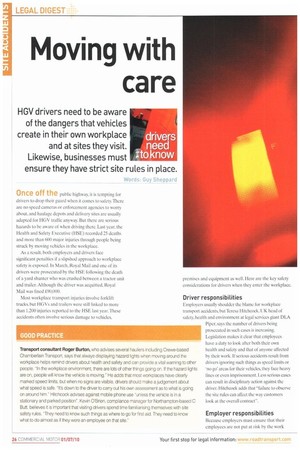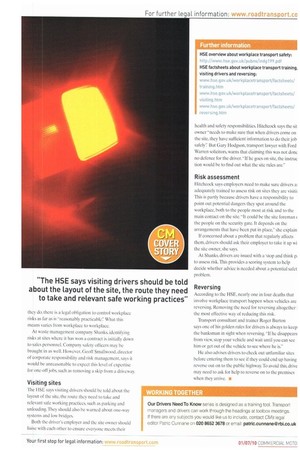Moving with care
Page 26

Page 27

If you've noticed an error in this article please click here to report it so we can fix it.
HGV drivers need to be aware -rz of the dangers that vehicles create in their own workplace drivers Likewise, businesses must and at sites they visit. ttoknow
need
ensure they have strict site rules in place.
Once off the public highway, it is tempting for drivers to drop their guard when it comes to safety. There are no speed cameras or enforcement agencies to won-y about, and haulage depots and delivery sites are usually adapted for HGV traffic anyway. But there are serious hazards to be aware of when driving there. Last year, the Health and Safety Executive (USE) recorded 25 deaths and more than 600 major injuries through people being struck by moving vehicles in the workplace.
As a result. both employers and drivers face significant penalties if a slipshod approach to workplace safety is exposed. In March, Royal Mail and one of its drivers were prosecuted by the HSE following the death of a yard shunter who was crushed between a tractor unit and trailer. Although the driver was acquitted, Royal Mail was fined £90.000.
Most workplace transport injuries involve forklift trucks. but HGVs and trailers were still linked to more than 1.200 injuries reported to the HSE last year. These accidents often involve serious damage to vehicles.
Driver responsibilities
Employers usually shoulder the blame for workplace
transport accidents, but Teresa 1.1itchcock,1IK head of
safety, health and environment at legal services giant DLA Piper. says the number of drivers being prosecuted in such cases is increasing. Legislation makes it clear that employees have a duty to look after both their mm health and safety and that of anyone affected by their work. If serious accidents result from drivers ignoring such things as speed limits or 'no go' areas for their vehicles, they face heavy fines or even imprisonment. Less serious cases can result in disciplinary action against the driver. Hitchcock adds that "failure to observe the site rules can affect the way customers look at the overall contract".
Employer responsibilities Because employers must ensure that their employees are not put at risk by the work they do. there is a legal obligation to control workplace risks as far as is "reasonably practicable': What this means varies from workplace to workplace.
At waste management company Shanks, identifying risks at sites where it has won a contract is initially down to sales personnel. Company safety officers may be brought in as well. However, Geoff Smallwood, director of corporate responsibility and risk management, says it would be unreasonable to expect this level of expertise for one-off jobs, such as removing a skip from a driveway.
Visiting sites
the USE says visiting drivers should be told about the layout of the site, the route they need to take and relevant safe working practices, such as parking and unloading. They should also be warned about one-way systems and low bridges.
Both the driver's employer and the site owner should liaise with each other to ensure everyone meets their health and safety responsibilities. Hitchcock says the sit owner "needs to make sure that when drivers come on the site, they have sufficient information to do their job safely': But Gary Hodgson, transport lawyer with Ford Warren solicitors, warns that claiming this was not done no defence for the driver. 'If he goes on site, the instruc Lion would be to find out what the site rules are."
Risk assessment Hitchcock says employers need to make sure drivers al adequately trained to assess risk on sites they are visitii This is partly because drivers have a responsibility to point out potential dangers they spot around the workplace, both to the people most at risk and to the main contact on the site. "It could be the site foreman ( the people on the security gate. It depends on the arrangements that have been put in place," she explain If concerned about a problem that regularly affects them, drivers should ask their employer to take it up wi the site owner, she says.
At Shanks, drivers are issued with a 'stop and think II to assess risk. This provides a scoring system to help decide whether advice is needed about a potential safet problem.
Reversing According to the HSE, nearly one in four deaths that invol% e workplace transport happen when vehicles are reversing. Removing the need for reversing altogetheri the most effective way of reducing this risk.
Transport consultant and trainer Roger Burton says one of his golden rules for drivers is always to keep the banksman in sight when reversing. 'If he disappears from view, stop your vehicle and wait until you can see him or get out of the vehicle to see where he is."
He also advises drivers to check out unfamiliar sites before entering them to see if they could end up having reverse out on to the public highway.To avoid this, drive may need to ask for help to reverse on to the premises when they arrive. •




































































































































